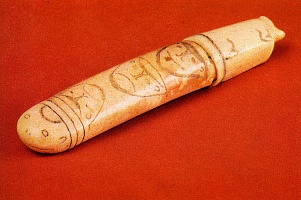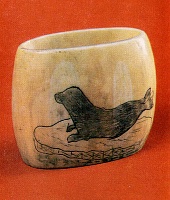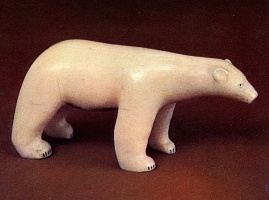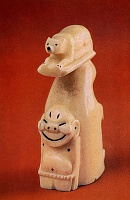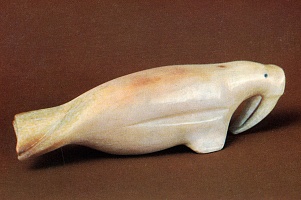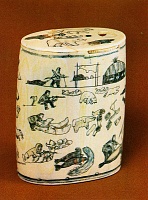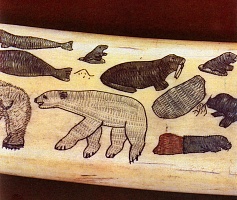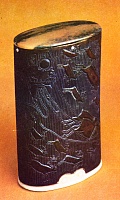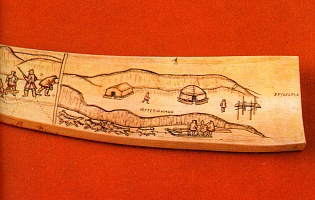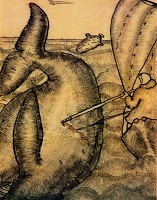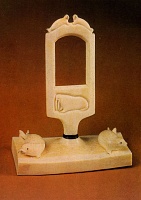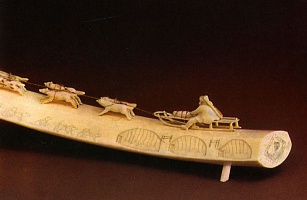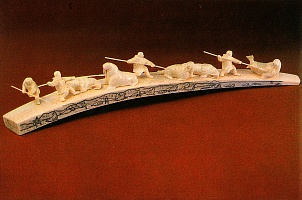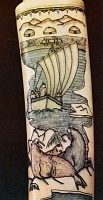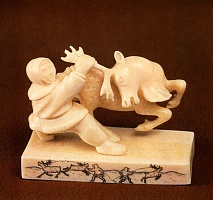Chukchi Art of Bone Carving
In the 1960s – 1970s, Ako, Vera Amkul and Tukkai worked successfully in this handicraft center. A talented engraver Vera Amkul inherited deep traditions of Chukchi and Eskimo engraving in bone and developed this kind of art, introducing new features. The Museum presents Amkul’s works illustrating fairy tales. They are “Kele and Little Bird”, “Bear’s Son”, “Dog Riot”, “Fairy Tale”, etc. Tukkai’s works are also very interesting.
Bone carving and engraving among Chukchi and Eskimo is a sphere of material and spiritual culture that retained archaic features until recently. It emerged in ancient times and developed through a long and difficult way. The Museum collection of Chukchi and Eskimo art contains about 1500 items. The most interesting part, amounting to 90 % of the total number, presents the works of the 1920s – first half of the 1930s. It was collected by the Integral center in Chukotka in the early 1930s and was previously preserved in the Moscow Museum of Folk Handicrafts. The collection demonstrates the variety of Chukchi and Eskimo art.
It is includes not only miniature sculpture, bone relief carving and engraving, but also embroidery, craftsmen and children’s drawings. Chukchi and Eskimo bone carving of the 1920s inherited the cultural traditions of the late 19th – early 20th century, when many souvenirs appeared as the result of the developing trade with American and European merchants and whale catchers.
In the early 20th century, walrus tusks with engraving appeared. By the 1920s, walrus tusk engraving had developed in a certain way. In general, the works of the 1920s stuck to the traditional style and techniques of Chukchi and Eskimo bone carving, but they became more decorative, narrative and compositionally complicated.
The razor case (1920s) of walrus tusk shows sketchy faces. The paper knife (1920s) with an engraved walrus shoal on the blade is interesting.
In contrast to the 1920s, when bone carving developed within the traditions of the late 19th – early 20th century, in the 1930s, the significant changes were connected with the establishment of the new forms in life and culture in Chukotka. In 1931, the Bone Carving Studio was opened in Uelen. It became a center of Chukchi and Eskimo art.Animals were still the main artistic characters. The reflection of real life in combination with fantasy of the fairy tales and myths made the works of art more poetic and expressive. The images of bears, hares, arctic foxes, billikens were static, their silhouettes with cut off sides looked as if they were chopped.
The collection of Chukchi and Eskimo art in the Sergiev Posad Museum is remarkable for wide representation of the craftsmen’s drawings of the 1933- 1936. They provide valuable material for the investigation of thematic engraving. The drawings permit to estimate the artist’s creative individuality and to observe how new trends were perceived and reflected in art of Keinitegyn, Vukvol, Onno, Renvil, Mynor and other Uelen artists of younger generation. The Dezhnev artists - Roshilin, Ichel, Leivun were more traditional.
Roshilin is an outstanding personality. His engraving in bone and pencil drawings are marked by a quick eye, a wide variety of subjects, characteristic only of his art. Roshilin roamed the tundra before he mastered carving in bone and when he was a recognized artist. Roshilin’s scenes are depicted in a laconic contour in profile. The scattered images are flat and different in scale. Each scene is compositionally accomplished.
Ichel is one of the eldest craftsmen. His large-scale drawings are flat. The scenes, depicted mainly in profile, cover the whole surface of the tusk. The engraving technique is varied, the author used a wavy zigzag line to depict deer, walruses, yarangas, whaleboats; parallel vertical or checked stripes to decorate clothes, dotted engraving to tint figures.
Leinvun descended from a family of famous bone-carvers in the settlement of Dezhnev. Leivun made a tusk with an engraved team of deer on one side and Dezhnev settlement on the other in the 1930s, probably somewhat later, than his other works.
Vukvol is a hereditary bone-carver. We know several Vukvol works, depicting festival dancing. The collection also includes some works made by Vukvol in cooperation with other carvers. Vukvol works, presented in the Museum, characterize the author, as one of the major talented Chukchi artists.
Onno, like Vukvol, is a representative of a younger generation, easily assimilating new tendencies, that penetrated into Chukchi and Eskimo art in the 1930s. Onno is a master of engraving in bone. He prefers different hunting scenes. The engraved tusk (1930s) demonstrates the achievements of the leading craftsmen of this center. It was created by four artists, each created his own independent drawing that was not connected with drawings of the other participants.
Keinitegyn became a bone-carver in the 1930s. The researchers of Chukchi and Eskimo art know him as a carver, author of expressive sculptures of deer. Keinitegyn was also an outstanding engraver and graphic artist. The engraved tusk and a series of drawings brightly manifest his talent. In the 1930s, no artist was equal to Keinitegyn in the expressiveness of animal images.
The works of the 1940s – 1970s, included in the Museum collection, were created by the leading artists Bukvutagin, Onno, Khukhutan, Keinitegyn, Khotkhyrgin, Tukkai, Ako, Amkul, Khuvat, Tynatval, Yanku. They demonstrate art of those years. At that time the techniques became more complicated, the color schemes- more varied. Sculpture of the 1940s shows that images were still represented in profile, tusks were used as platforms for figures, compositions became more detailed.
The works of the 1950s are noted for the reinforcement of realistic features. At that time there appeared sculptural groups with complicated compositional treatment, made of a single piece of bone. Vukvutagin became a bone carver in the 1930s. His sculptural composition “Dog Team” (1945) shows real images of animals and people.
Khukhutan was one of the few talented artists who equally mastered engraving, high and low relief carving. Decorative knives with sculptural handles and engraved sheathes were characteristic.
In the 1960s – 1970s , there successfully worked Ako, Vera Amkul and Tukkai. Vera Amkul, a talented engraver, inherited deep traditions of Chukchi and Eskimo engraving in bone and, at the same time, developed this art introducing new features into it. The Museum presents Amkul’s works illustrating fabulous stories: “Kele and Birds”, “Bear’s Son”, “Dog Riot”, “Fairy Tale”, etc. The works, created by Tukai, are also interesting.
Chukchi and Eskimo art is integral and poetic, it has deep traditions. Selecting and consolidating the best achievements, contemporary art of Chukchi and Eskimo develops, involving a new generation of craftsmen into centuries-old culture.









